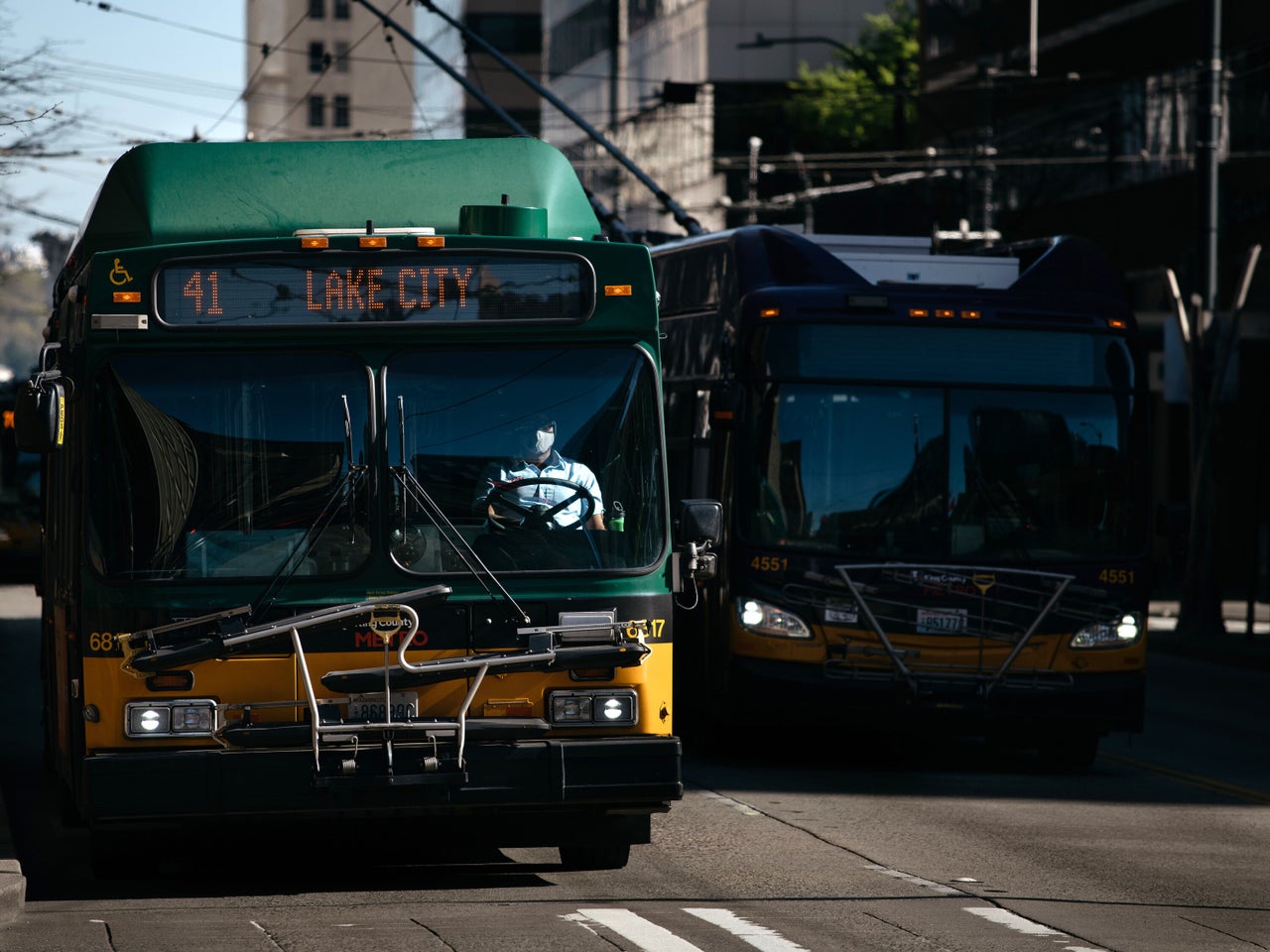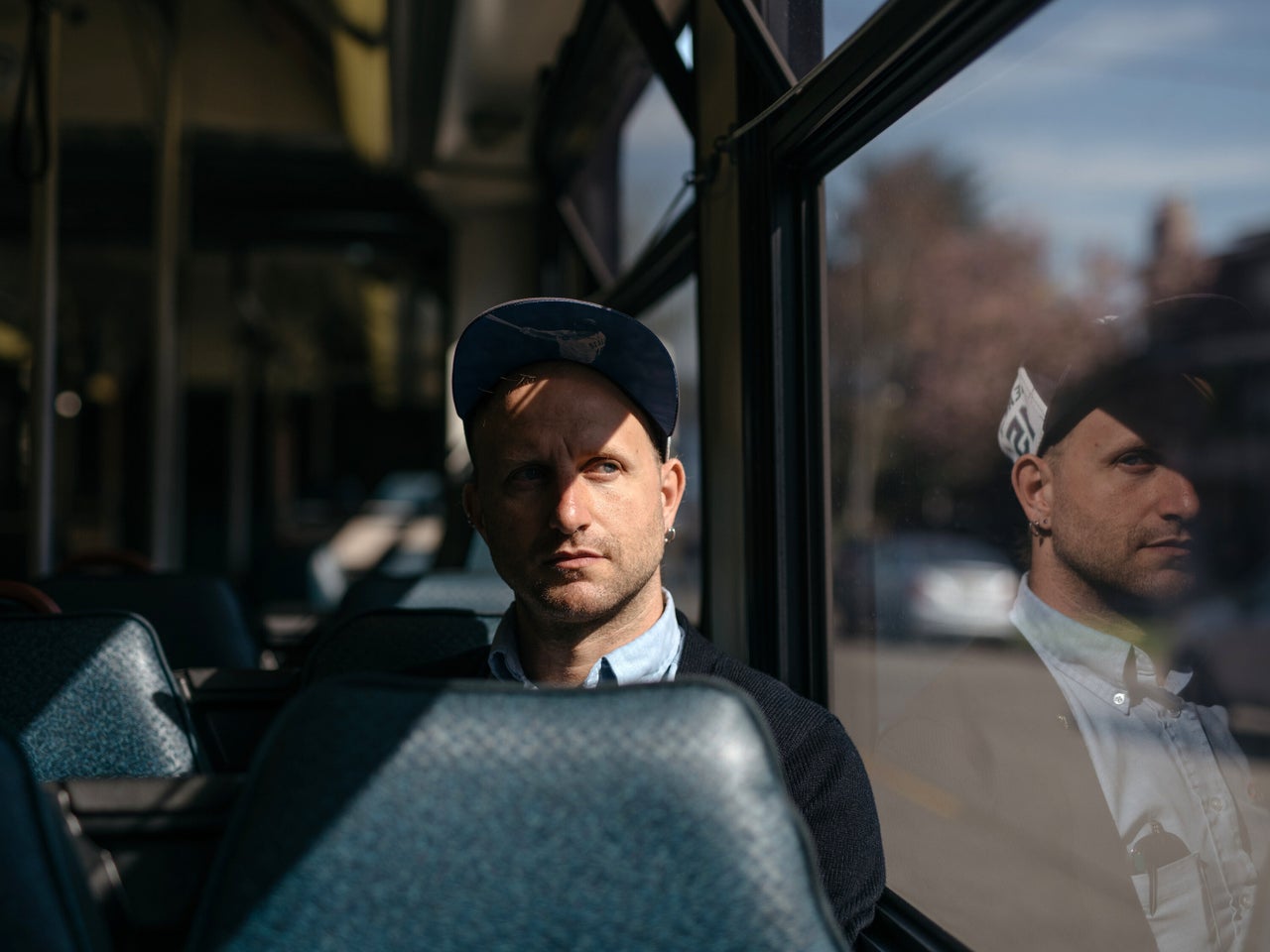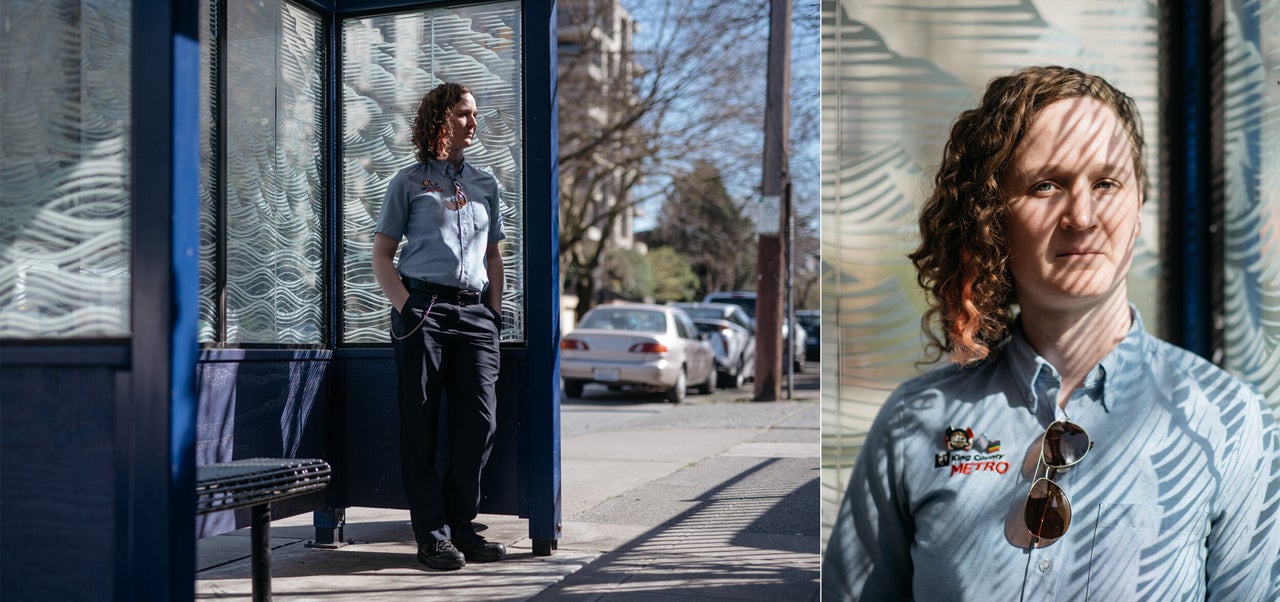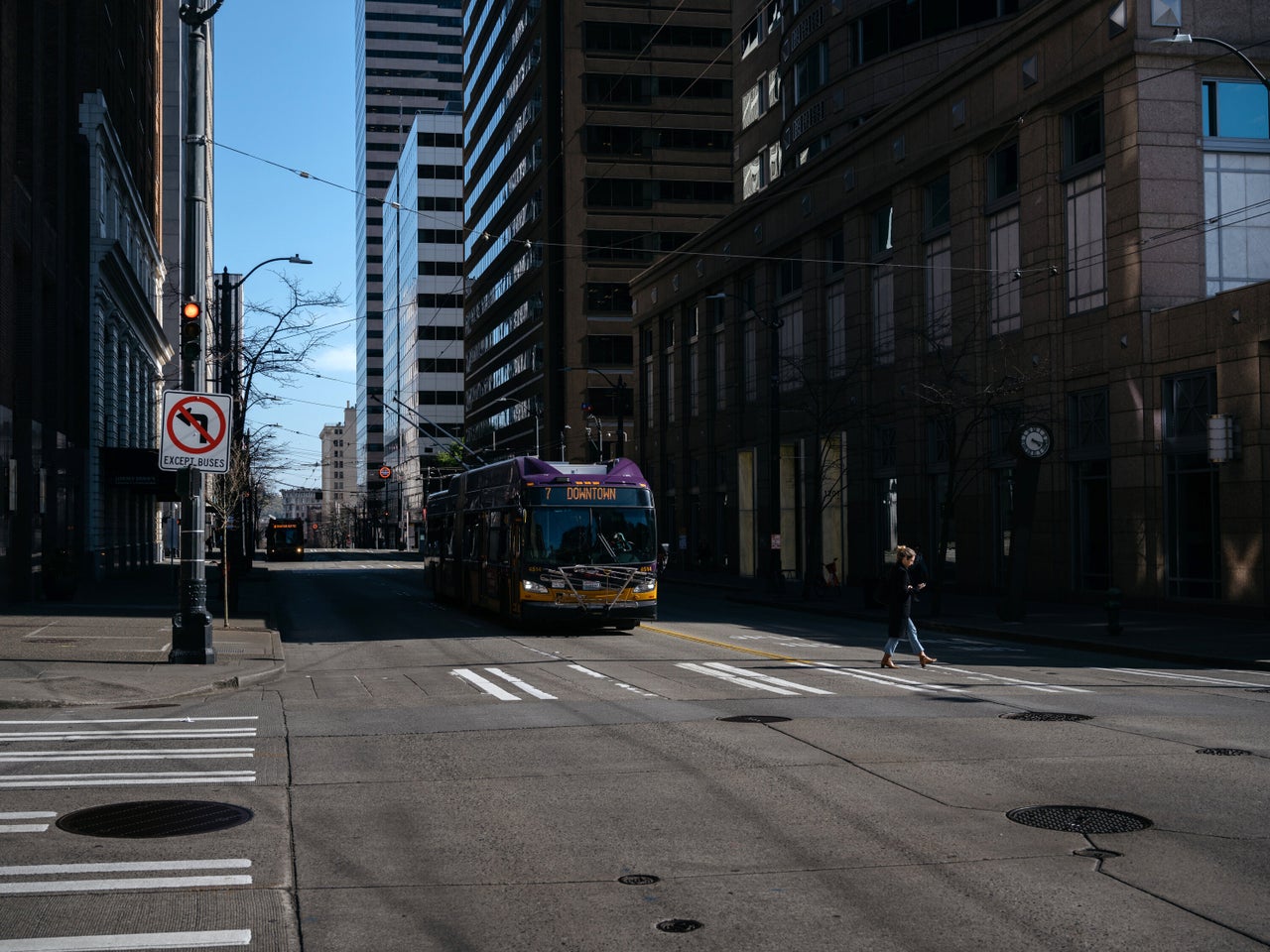SEATTLE ― Driving a city bus has always had its hazards. Until recently, exposure to a deadly pandemic was not among them. But as most workers are staying home to avoid exposure to the coronavirus, bus drivers remain on the front lines, transporting strangers around the city in what one driver referred to as “rolling petri dishes.”
With protective equipment such as masks and gloves in short supply, drivers say they have no way of knowing whether they’ve been exposed. Every interaction with a rider, another driver said, is a potential opportunity for infection: “Everybody’s got a gun now, but we don’t know who has bullets.”
In Seattle, where the first U.S. cases of COVID-19, the illness caused by the novel coronavirus, were detected in February, conversations with nearly a dozen bus drivers revealed widespread anxiety about driver and passenger safety.
While many drivers sympathize with riders who still rely on buses to get to work or the store ― or just have nowhere else to go ― some drivers said they didn’t understand why so many buses were still on the road. They have no idea how many of their fellow drivers have been infected because the public transit authority, King County Metro, won’t say. And drivers are frustrated with what they see as a lack of clear direction from management about how to protect themselves, when to stay home, and how they will be compensated if they take time off.
Nathan Vass is a veteran Metro driver who recently decided to take unpaid time off because he thinks he may have been exposed to the coronavirus. He said that his route, which is one of the busiest in the city, has remained crowded through the pandemic — an observation confirmed by Metro’s ridership statistics, which show that buses serving lower-income areas, like the one Vass drives, have seen much lower reductions than commuter and suburban routes.

Vass said he’s not sure what’s worse: Failing to serve people who rely on transit by shutting the buses down, or allowing the virus to spread unchecked by keeping them in service.
“If we’re going to continue allowing transit, we have to be OK with the fact that we’re spreading the virus as well,” said Vass, who recently published a book chronicling his experiences as a bus driver. “Transit is just not conducive to restricting the transmission of viruses.”
Metro, like other transit systems across the country, has reduced service dramatically during the pandemic. But drivers in Seattle — unlike, for example, in Vancouver, Canada, where the bus agency recently closed off every second row of seats — have been offered limited official options for enforcing social distance.
A recorded message, which is only in English, instructs riders to sit six feet apart, but that’s an impossible standard to achieve on the more crowded routes. And even if riders do sit six feet apart, the coronavirus lingers on surfaces, so if an infected person sneezes on a handrail or touches a seat with dirty hands, they can still infect the next person who sits there.
At the same time, Metro has officially designated bus drivers “first responders” and instructed all drivers who don’t show COVID-19 symptoms to keep showing up for work, even if they think they’ve been exposed to the virus.
“That is the opposite of everything we’ve been told, from CDC on down,” said Audrey Monroe, who has driven for Metro for almost four years. “It seems wild to me that that’s their policy when we know that you can have no symptoms and still be shedding the virus.”
Metro will not say how many drivers have been infected. According to King County Metro spokesperson Jeff Switzer, releasing illness numbers “could lead to individuals being identified and could cause other spaces to be mistakenly seen as being without risk,” and might cause drivers not to seek needed medical care. A driver for Community Transit, an agency that serves the suburbs north of Seattle, died of COVID-19 last month; so far, the agency has confirmed 10 cases among its drivers.
One Metro driver, who asked to remain anonymous because she was concerned about retaliation for speaking with the press, said she suspects the agency is concealing the number of cases to avoid alarming drivers and riders.
“We have three or four times more drivers” than suburban Community Transit, she said, “and I do not believe in a million years that we don’t have exponentially more” cases. “I believe public transit should have been shut down because we are transporting this disease and we are extending the curve” of infections, she said.
In Seattle, as in many other cities, transit agencies have suspended fare collection and have recently cordoned off the front sections of buses or trains with caution tape to protect drivers, but elderly riders and those with wheelchairs, canes or walkers can still board on the front.
“I’ve had to get out of my seat and help people [secure their] wheelchairs, which puts me in really close proximity to people,” driver Jeremy Une said. Une drives several of the routes that remain crowded, including one that goes through a busy hospital complex. “Some operators are feeling that even that little bit of contact is too much,” he said.
Kahu Pene is one of those drivers. He was securing a rider’s wheelchair when he felt droplets from the passenger’s mouth on his face. “I am in the at-risk category — I’m over 60 — but I don’t have any underlying health issues,” he said. Nonetheless, he’s now in self-isolation, just in case. “I think it’s just a contradiction — they have all these signs at work that say we’re supposed to maintain all this social distance, and yet we have to act as normal when it comes to ADA riders.”
Struggling To Stay Safe
Several drivers said they’ve received conflicting information about how to protect themselves. Currently, drivers get bottles of Purell, cans of alcohol-based wipes, and one pair of latex gloves per day. So far, Metro has not advised drivers to wear masks, although many have been doing so anyway, and Switzer, the Metro spokesperson, said Thursday that the agency has ordered 154,000 surgical masks and expects to receive a first shipment “soon.”
Some drivers said they feel unprotected and under-informed. “I wipe down my bus every time I get an opportunity,” said David Reuter, who has been driving since late last year. “But it’s a confined space, and the virus can live in the air. So that doesn’t feel super safe.”

Monroe said she had been trying to arrive at the bus base early to thoroughly disinfect her space. But recently, she said, she had to pick up a bus mid-route, swapping out with another driver with passengers on the bus. “I didn’t have 10 minutes to wipe everything down. I just drove until we got to the layover, and I could wipe it down then.”
In general, Monroe said, she thinks Metro has been “chasing” the pandemic. She said that when she was driving, she was “honestly kind of terrified most days” about bringing the virus home and “spreading it around without knowing.”
Sam Smith, a driver who is starting a new route this week after three weeks off, is disturbed by the fact that drivers are only given one pair of latex gloves per day when the Centers for Disease Control and Prevention advises discarding gloves every time they are taken off. Recently, he said, he had to pick up a dirty shirt off the bus floor and return it to Metro’s lost and found, which forced him to decide between using up his only pair of gloves for the day or washing his hands as soon as possible and preserving his gloves for the last part of his shift.
“Normally, stuff like that is just gross, and the worst thing you’re worried about is bedbugs,” he said. “Now it’s bedbugs and coronavirus.”
Deciding Whether To Stay Home
Drivers also worry that they’ll have to burn through all their paid time off to deal with a crisis no one anticipated. Metro’s policy differs by seniority and for part-time and full-time drivers, but in general, drivers are required to use up all their paid sick, vacation and other paid leave before they can qualify for other types of paid time off, including paid administrative leave, which is currently available for work scheduled through April 24. County employees are also allowed to donate to, and draw from, a “pool” of sick and vacation time.
Some drivers said they planned to keep driving even if they believed they were exposed because they couldn’t afford to risk losing their income or using up sick time they might need later.

Until this week, Monroe, who has asthma and uses an inhaler, was among them. Although taking time off will mean using up all her sick, vacation and comp time, she decided that driving was no longer worth the risk. Moore said Metro’s policies could encourage drivers to show up sick. “It feels like if they had our health in mind, they would be trying to make some sort of concessions,” she said. “I’d like to go back to work as soon as it feels safe, but I don’t know when that will be.”
Beyond their own fears about contracting the virus, drivers say they miss the camaraderie and daily contact they used to have with their regular riders now that many are no longer taking the bus, and those who do are cordoned off into the back.
Vass, the driver who is staying home because he fears he was exposed to the virus, said he feels “weird talking about driving people around, and transit in general, as something that’s problematic. I was picking up people who were visibly ill, and normally that never would have concerned me, but now I do find myself reacting out of anxiety and fear. ‘Oh, no, does this person have the virus? Am I going to give this person the virus because they’re vulnerable?‘’’
“I don’t like being in that headspace,” he continued. “I fear that virus fear is affecting my judgment.”
Keeping The Buses Running
While ridership has plummeted overall, drivers said they have noticed a dramatic uptick in the number of riders who appear to be homeless, including “non-destination riders” — people who ride the bus from end to end, sometimes all day. There are many possible explanations for this increase — several drivers thought it was because the buses are now free — but one likely reason is that homeless people have fewer places to go during the day now that libraries, day centers, and community centers are closed.

“It’s sort of like it’s one in the morning all the time” on his route, Vass said, with few commuters or riders traveling to appointments. Last month, he said, “I was primarily transporting people who were just riding back and forth. I just feel awful for them — they’ve been thrown out on the street and their options are so minimal.” But, he added, “Once that population has the virus, you’ve just lost the whole city.”
Drivers are also aware that many people rely on their services. Une believes Metro has an obligation to keep the buses running.
“I’m taking people to work,” he said, including medical workers and people who provide essential services such as grocery store employees. “If we were to shut down, it would shut down a lot more than just transit, and I don’t think we can afford to do that.”
A HuffPost Guide To Coronavirus
- Stay up to date with our live blog as we cover the COVID-19 pandemic
- How long are asymptomatic carriers contagious?
- What to do if you can’t pay rent right now
- How to switch off from work when home is your office
- Why we should forgive student loans for doctors on the front lines
- How to make a face mask with just a bandana
- How long does coronavirus live in the air?
- The HuffPost guide to working from home
- What coronavirus questions are on your mind right now? We want to help you find answers.
- Everyone deserves accurate information about COVID-19. Support journalism without a paywall — and keep it free for everyone — by becoming a HuffPost member today.
